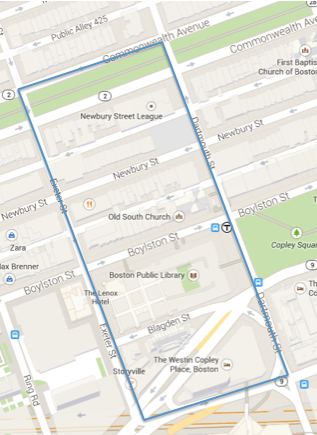 My site
My site
The site I chose is a rectangle of blocks bound by Exeter St, Commonwealth Ave, Dartmouth St, and Stuart St. I felt that this site was fascinating because it encompasses so much: residential life, shopping, green space, and the historic buildings of Copley Square. I chose this site for many reasons. One reason was genuine interest: I study at the Boston Public Library a lot, and I think the entire Copley area is very historically significant. I also think the area I chose gives a “cross section” of Back Bay. Each street varies in what it has to offer: while Commonwealth Ave is mainly residential, Newbury St is mainly shopping. Below are some initial land use observations I had:
 Satellite View of site area with initial land use notes.
Satellite View of site area with initial land use notes.
I thought it was particularly interesting to see such a wide variety of land uses, given that there are no breaks in the land. Clay describes the impact that breaks have on the partition of a city’s land—but Back Bay is man-made land with no clear geographic breaks. However, it has developed into an area that has residential, green, and commercial areas overlapping. This raised a question to me: did each street develop independently? Have some areas undergone more recent changes?
 Buildings of different styles on Commonwealth Ave.
Buildings of different styles on Commonwealth Ave.
One of the curious things I noticed as I investigated my site was the variety in styles and ages of the buildings, particularly on Commonwealth Avenue. The block I observed showed clear differences in the ages and styles of different buildings. I found these buildings fascinating because they look drastically different from one another. Were they built at different times? Why would the style change so much in less than 150 years? Why is the brick/stone so different, and was this dependent on resources and style? These are some of the initial questions that came to mind.
Unfortunately, because of the snow, I did not get to explore the green strip (called the “Commonwealth Ave Mall”) on Commonwealth Ave because the path through it was not plowed. However, I look forward to exploring it once the paths are cleared out. One initial observation I had was the arrangement of trees. They are in 2 rows, which reminded me a lot of the beautiful boulevards in Europe (particularly France). I’m curious to learn why it is designed this way, and why the designers of Back Bay chose to have a green strip of land along Commonwealth Ave. One conjecture I have is it could be potentially a way to connect Boston Common to another location easily by a walkway.
 School in the middle of stores on Newbury St.
School in the middle of stores on Newbury St. The Newbury Street block is also interesting. Newbury St, to me, has always been known as the high-end fashion area of Boston. In this sense, it is an epitome district. As Clay states, epitome districts have “the capacity to pack up emotions, energy, or history into a small place”. Even on a snowy day in Boston, people were window shopping on Newbury St. I think anyone who lives in Boston looks at Newbury St. as a symbol of wealth and high-end shopping. The beautiful brownstones look like old apartments that were made into nice boutiques. Newbury St. is the place a person would go in order to get a feeling for what the Back Bay area (near Boston Common) is like. One interesting anomaly I found between the storefronts was the Snowden International School, at the intersection of Newbury St and Dartmouth St. This building looks very different from the packed brownstones next to it. It is a Boston Public school, but it looks very ornate for a school. This made me believe it could have been used for a different purpose before it was a school. I look forward to doing more research to figure out what the school used to be used for, and also why a public school would be in this area. I also want to learn more about whether or not Newbury St. was always a shopping district, or if it used to be residential, since most of the buildings are quite similar to those on Commonwealth Ave.
One of the most historic areas in Boston is Copley Square. The Boston Public Library is one of the largest libraries in the country, and was constructed in 1848. One question this raised was whether or not Copley Square grew around the Boston Public Library, or if the Boston Public Library was built in Copley Square because Copley was already significant. There is a T stop right outside of the library, indicating that the area has been significant at least since the early 1900s. I am curious to learn more about the library’s history and its impact on the development of Copley Square. For now, I just admired the beautiful architecture (what was it inspired by? Who built it?) and took a few photos.
 Side view of the Boston Public Library: "The Commonwealth Requires the Education of its People"
.
Side view of the Boston Public Library: "The Commonwealth Requires the Education of its People"
.
I think exploring the architecture of the Boston Public Library and its relationship to the Back Bay area will be one of the more interesting things I discover about my site. I find the varying styles of buildings in my site to be intriguing, especially since the area has only existed for less than 200 years. While I have not had the chance to explore the areas behind the Boston Public Library (Blagden St), I look forward to seeing what architectural and land use differences I observe there. I am excited to learn about the natural processes and cultural changes that made my site such a historic and significant area.